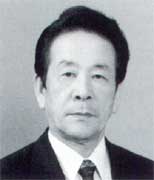- Thank you, Whales!
Kaoru Furukawa
Writer
Winner of the Naoki Literary Award / Board Member of the Group to Preserve Whale Dietary Culture of Shimonoseki - Thank you, whales. I pray for your soul.
Takashi Ishii
Master Violin Maker - The Future of Sustainable Use In the Globalization Environment
Janice S. Henke
Anthropologist
ISANA Dec. 2004 No.30
index
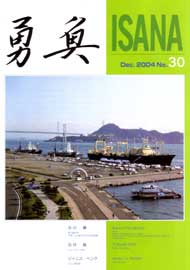
ISANA Dec. 2004 No.30
Thank you, Whales!

Writer
Winner of the Naoki Literary Award
Board Member of the Group to Preserve Whale Dietary Culture of Shimonoseki
Savior in the years of hunger
Shimonoseki is a whale town. Oka Juro, who for the first time used the Norwegian-type whaling method and is known as the father of Japan's modern whaling, comes from Nago, Abu-gun, Yamaguchi Prefecture. Nippon Enyo Gyogyo Kabushiki Kaisha (Japan Distant-water Fishery Co., Ltd.) he established had its head office in Senzaki.
Toyo Whaling Co., which developed later from that company, constructed its head office building in Ojiyama, Hanano-cho, Shimonoseki.
The photos left to this day show that the head office, built at the end of the Meiji Period (1868-1912), was a simple but elegant Western-style wooden building. It embodies the vigorous courage of modern whalers in the initial years of whaling, whose ambition from here launched the Antarctic whaling.
The factory-type whaling in the Antarctic started in 1934, and from Japan as many as six fleets operated there. When World War II raged, the supply of whale meat--a favorite of the Japanese people--stopped. It is because of this suspension that I do not remember eating whale meat during the period when I suffered from hunger.
When permission for the Antarctic whaling was given after the war, whaling soon saw its prime time, assuming the role of a savior who supplied animal protein to hunger-stricken people.
Whale Steak as main dish
For youth having an avid appetite, the steak of dried whale meat--called "Shio-kujira" (salted whale meat)--was truly palatable food deserving the name of the main dish. The taste of Makkari (a kind of liquor made from cereal and wheat) while chewing Shio-kujira in the back alleys of Hogakuza Street in Shimonoseki is a youthful reminiscence of the taste deeply imprinted in the minds of men who were born in the 1920s.
Around that time, the Tenyo Maru, a carrier boat belonging to the Nisshin Maru fleet, entered Shimonoseki port--a whaling base--with its hold full of whale meat. The gift presented at a gorgeous welcome party held in a warehouse was nearly 1 kilogram of whale tail meat.
When we knew the taste of whale tail meat, which is said to be more relishing than beef, we inclined to stay away from Shio-kujira which we had eaten avidly previously, and instead sought tail meat and whale bacon. That might have been the Japanese people's luxury at the beginning of the age of economic excessiveness.
However no matter what others tell us, we have nostalgia for the taste of whale meat.
Drinking liquor with broiled salted red meat reminds us of the taste of our home town. The combination of tail meat and pure rice sake is superb, and eating high-quality bacon gives us a true bliss of intoxication.
Whale tomb -- a focal point of international understanding of whaling
The whaling issue embodies a clash of cultures which is difficult to be harmonized. I would like to tell the anti-whaling campaigners about the love of animals that has been practiced in whaling in Choshu (now Yamaguchi Prefecture).
At the entrance of a temple dedicated to Kannon (one of the most popular bodhisattvas in Japan personifying infinite compassion) within the precinct of Koganji Temple in Nagato, which had been a whaling area overlooking the Sea of Japan, you can find a tomb dedicated to whales. The tomb was constructed at the end of the 17th century, and Buddhist mortuary tablets are enshrined in the temple. Separately, there is a record of the Buddhist names of 85 whale fetuses. It often happened that a fetus was found when flensing a whale. Fishermen had pity for the fetuses and held memorial services for whales every year. This practice has been continued even to this day. They accepted with a devout religious sentiment nature's law that human beings should catch and eat animals for their own survival.
Kaneko Misuzu (1903~30), a nursery rhyme poet from this area which once thrived on whaling, wrote something like the following in her poem titled "Big Harvest.
In the sunrise glow
We had a big harvest
A big harvest of sardines
It is as if a festival is going on the beaches
But probably in the sea
There will be funerals for tens of thousand of sardines
The sensitivity of the poet who expressed the sense of guilt to the law of the jungle is considered to have been fostered by the traditional view of nature by the Japanese.
The history of whaling in Choshu, symbolized by the whale tomb, teaches us about the "symbiotic relationship between man and animals" in which the use of animals for food and the gentleness towards animals do not contradict each other.
Unlike whaling practiced in Western countries in which only the oil was extracted and the remaining body was discarded, the Japanese have utilized whales from the bones to the skin, to say nothing of the oil. We consume without any waste the living resources which we have captured for our survival. The solemn relationship of coexistence between man and food animals is completed by having the life of captured animals be renewed as a new life as human beings.
On the monument dedicated to the whales, erected at the side of "Kaikyokan," a Shimonoseki municipal aquarium, an epithet is engraved in large letters saying "Thank you, dear whales!" written by an elementary school pupil. For me who lived through the years of hunger, these words of gratitude carry a deep emotional tone, but I think it is the universal sentiment of the Japanese people. The whale tomb which tells us of the fishermen's sympathy towards the whale fetus is the starting point of animal welfare. We believe international understanding on whaling should start here.
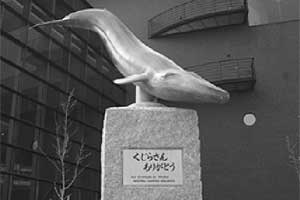
Monument dedicated to whales erected at the side of the Shimonoseki municipal aquarium "Kaikyokan"
Thank you, whales. I pray for your soul.

Master Violin Maker
The word "whale" immediately reminds me of food. At the same time, it also reminds me of violin strings. Whale baleen is used to fix the vital part of a high-quality string, namely, where the right fingers touch. Whales thus are useful for such a purpose.
The Italian word for a whale is "balena." It is also used to mean a fat lady. A woman who was as slender as a smelt as a young girl gradually gains weight to approach the shape of a whale. My wife, Giuseppina, probably can be classified as a minke whale, not yet a blue whale. I myself am like a sardine or saury swimming hesitantly among many whales in Italy. This sardine has lived in Italy for about 35 years. During this period, I have not eaten any whale meat. I could not because whale meat is not sold in this country.
When I first arrived in Italy, I was very poor. I used to buy flour for business use and ate something like hot cakes and pancakes every day. At times I went to the butcher to buy chopped meat used for pet food for dogs and cats. I also used to eat tuna "toro" (the fatty flesh of tuna). The reason why a moneyless person as I could eat toro--which is of high value in Japan--was because Italians have no liking for that part of the tuna. (It was so when I was young and is still so today.) Therefore, they cut off and threw away that fatty part. I used to get it for free and ate it. Toro is my favorite because I am a great lover of fish. But I was really tired of it after I ate 1 to 2 kilograms of toro at a time. Anyway, in this way, I secured protein for myself. Toro is now very expensive in Italy because the Japanese are competing to buy it.
The reason why I brought up the topic of toro is to point out that Italians, and other Western people, do not need any food for which they have no preference because of their food culture and taste. Whale is just this case. Westerners satisfy themselves with eating beef, pork and poultry. I do not watch professional baseball or soccer games or professional wrestling because I have no interest in them. I can go perfectly all right without those sports. But I do not venture to tell their fans to prohibit the games.
It is an evident fact that former big whaling countries in the Western world, which are now against whaling, were responsible for having driven some species of whales to the brink of extinction by unrestricted and disorderly harvesting. But they are now blaming Japan as an uncivilized country for engaging in whaling, turning a blind eye to their old misdeeds. Admittedly, they knew that a single whale could save some people from malnutrition. Yet they hunted whales only for extracting the oil to lighten up their towns and cities, and openly discarded the meat, while knowing that there are people who were in need of the meat.
In 1878, the worst accident in the history of Japan's whaling occurred in the village of Taiji, Wakayama Prefecture, western Japan, which claimed the lives of 111 villagers who took part in whaling. (This accident is called "Osemi-nagare.") I think this disaster was triggered, indirectly and directly, by Americans. The life in Taiji was then in distress because large-scale whaling fleets from America had been exhausting whales in the offshore area, causing fewer whales swim to the coastal area. The villagers had a meager chance of catching whales and were compelled to venture to operate even under adverse sea and weather conditions in order to maintain their livelihood, and this is believed to have resulted in the said shipwreck. The village was driven to further poverty because of this accident.
A single whale could save the livelihood in the village. The purpose of the coming of the U.S. fleet led by Commodore Matthew Perry to Uraga, Kanagawa Prefecture, near Tokyo, in 1853 was to demand Japan to provide food and water to American whaling fleets. Their arrival imposed added hardships on people dependent on the bounty of the sea. Friendship was only an outward excuse.
At present, the International Convention for the Regulation of Whaling bans commercial whaling, and Japan is complying with the decision-- reluctantly. Research whaling is being carried out under some conditions, and the Japanese people can eat whale meat coming from the research. When I returned to Japan this summer, I had the opportunity of eating whale meat for the first time in 30 years. It tasted superb. More than that, I was filled with a nostalgic emotion as my childhood memory came back to me. I saw whale bacon being sold in a shopping mall in Hakata Station. When I was a child, my poor family living in Kitasenju, Tokyo, could eat whale bacon from time to time because it was an inexpensive food. I was surprised to find a small block of whale bacon at a store in Hakata Station priced between 4,000 to 5,000 yen--I first thought it was a mistake for 400 to 500 yen. The Western anti-whaling campaigners are to blame for this high price. They robbed us of our small pleasure.
Recently I watched an American-made TV program in Italy. It was a routine program telling us that whales are friends to mankind and should be treated with great care. But the program concluded by saying that it is regrettable that people in some part of America and southern Italy are eating dolphins. Cetaceans provide less expensive protein than beef and pork. They are not necessarily the most delicious food, but the fact that they are consumed means that they have been companions to mankind from time immemorial. It is because of this reason that the Japanese erect monuments to marine living things that are granted by heaven to help them to survive. This habit of holding memorial services for animals or instruments once used (for example, needles, artificial teeth, pipes or carpenter's tools) cannot be found in the Western world. Giuseppina's family is dairy farmers and they raise various animals. Several times, I saw the scene of slaughter of cattle and pigs. In her house, nicknames are given to ducks and geese. On one occasion, there was a dinner gathering of her relatives. Giuseppina's mother brought a goose on a big plate, saying she cooked it deliciously. That was "Antonio" that had been waddling in the yard until a short while ago. Although everybody ate it with much cherish, I could not.
"There was a bar on the ground floor of the apartment house where I used to live, and Elisabetta, a seven-year-old daughter of the house, had been cutting with scissors the legs of frogs for cooking. This was something I did not have the courage to do. I don't think the notion of cruelty differs from country to country. But in the Western countries, killing the animals they use for food is not considered cruel at all.
The sight of rabbits or lambs, being hung in the butcher's shops with their skin peeled, stimulate the appetite of western people, whereas we Japanese are shuddered to see it. It is not only whales that arouse the sense of pity. Why do western people have compassion only for whales? Most people believe that whales feed only on plankton. They don't know that whales eat fish in the amount five times as much as consumed by humans.
My wife is Italian and our two children are half-Japanese and half-Italian. They were born Catholic and inherited their food culture in the same way I became a Buddhist because I was born in Japan. Our children know about whales only through television and quite naturally they have embraced an anti-whaling emotion. However, they gradually came to have an understanding on whaling--partly as a result of my persuasion.
As a nation, Japan should continue its steady and patient effort to persuade Western people who do not understand or even do not try to understand. Not only for the whaling issue, but also for other issues of trade and international relations, it is crucial for the Japanese government to make its views clear without any hesitation as any other country does, giving the top priority to national interest.
Most affected by the anti-whaling campaign are: first, whales themselves and their feed because of the harsh competition over food as the number of whales increased; second, fishermen who make a living by catching whales and fish.
I am personally indignant only about the whaling policy of western countries and I have no intention of expressing my views on other international issues because I have no knowledge about them. I am not personally attacking many of my close friends in the western countries. But I believe it is my obligation to take time to convince them on the whaling issue.
Despite my poor stock of knowledge about whales, I wrote what came across my mind about whales in this essay. I may have been wrong on some points and I must admit that I become emotional when it comes to the topic of whales. My apology for any inconvenience I might have caused because of such shortcomings. Lastly, I take this opportunity to express my thanks and respect to the indefatigable effort of the staff of the Japan Whaling Association.
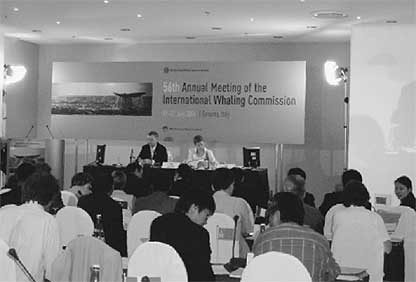
56th IWC Annual Meeting in Sorrent,Italy.
The Future of Sustainable Use In the Globalization Environment
The migration route of gray whales is a route where gray whales migrate between a breeding ground in the low-latitude area and a feeding ground in the high-latitude area. The migration route of the eastern Pacific stock (California stock) was a simple one, consisting of a single line. By contrast, that for the western Pacific stock (Korean stock, Asian stock), which was much smaller in stock size, was somewhat complex in the past. It has long been known that there were two migration routes: one in which the Korean stock (in a narrow sense), which constituted the mainstay of the western Pacific stock, migrated between the Okhotsk Sea and the South China Seas via the east coast off the Korean Peninsula, and the other in which the Japanese stock migrated northward and southward by passing along the coastal areas of the Japanese Archipelago. In the latter, the presence of a migration route in the east coast (on the Pacific side) of the Japanese Archipelago has been proved by the gray whales of Ichikawa, which is a archeological material, and the fact that gray whales had been caught off Wakayama and Kochi prefectures since the Edo Period. It is also proved by the records of ancient documents, which the author will cite in the following paragraphs.
A.G.Tomilin of the former Soviet Union considered that the gray whales that once were distributed in the east coast off the Kamchatka Peninsula and its vicinities belonged to the western Pacific stock. This means that the feeding ground for the east coast stock existed in the area. There is a view that the breeding ground for the east coast stock existed in the Seto Inland Sea, but this assumption has not been confirmed yet. I believe that the more likely area was the southern sea area of China.
Besides these, there existed another migration route in the west coast of the Japanese Archipelago, in other words, in the east coast of the Sea of Japan (East Sea). The gray whales, which used to migrate along this route, had been caught since the Edo Period off the north coast of Yamaguchi prefecture and the northwest coast off Kyushu, where whaling thrived from early times. Nevertheless, the presence of their migration route has been not only dismissed but also denied. But it can be confirmed by several documentary materials that a migration route did exist along the west coast. Because of the limited space allotted for this paper, I would like to present only a brief summary.
To begin with, let us have a look at documents from the 19th century. The "Illustrated Book of Whaling," by SankeyFujikawa, published in 1889, cited the words of an old whaler about “the moving way of the whalesEand said: "The whales of the Choshu region are the same ones as the whales in the Korean Sea ... The whales of Echizen and Kaga are the same with the whales of the Ezo region and many of them aree fin whales and gray whales. It is the same for the whales of the Manchurian Sea ... There are many fin, sperm and gray whales in the area off the Kurile Islands." It further said: "There are many humpback, sei, fin and gray whales in the Kishu and Toshu seas in early winter ... There are many fin, gray and sei whales in the area off the Yonewaki Village in Echizen, and the whaling season is set from March to May.EThese records tell us that there occurred many gray whales in the Wakayama and Kochi prefectures on the east coast and also in the Fukui prefecture (Echizen) and the southern part of the Ishikawa prefecture (Kaga) on the west coast. The fact that there occurred many gray whales in the area around the Kurile Islands seems to show that the east coast stock of gray whales made northward and southward migration along the islands.
The "New Discussion on Whaling" by Tatsuo Mishima, published in 1899, said, in explaining about the period and location of whaling, “that fin, gray and sei whales are found off the coasts of Echizen and Kaga between March and May.EAlthough it is not clear about occurrence of the sei whale, the occurrence of gray whales in the Echizen and Kaga regions coincides with the description of the “Illustrated Book of Whaling.E
The "Norwegian-type Whaling in Japan," by Kiichi Akashi (1910) published in the early 20th century said that “gray whales are divided into three groups: blue, red and white; and they are found in large number in Kaga, Noto, Awa, Kishu, Tosa, Hizen, and especially in the Korean Sea, and their peak period is from late in December to around January." This record, which appears to have high credibility, tells us that gray whales migrated between the southern part of Chiba prefecture and the Kochi prefecture, and were also occurred in the area from the Noto Peninsula to the northwest coast of Kyushu on the west coast.
Finally, according to Masao Nakamura, "Natural Resources of Niigata Prefecture," published by the Nakano Foundation and the Niigata Prefectural Office in 1925, it is said that "gray whales at times approach up to 2-3 chos from the coast, but their sighting is very rare in recent years." The description is simple 8 but the contents are concrete. It shows that gray whales migrated to only about 200 plus E300 plus meters (1 cho is about 109 meters) from the coast.
The above documents seem to prove the presence of a migration route of the west coast stock of gray whales along the west coast of the Japanese Archipelago. Although it is estimated that the breeding ground for the west coast stock of gray whales existed along the south coast of China, its feeding ground was certainly in the Okhotsk Sea. The west coast stock of gray whales entered the Okhotsk Sea via the Soya Strait.
Takashi Sato stated in his "Treatise of Whaling in Hokkaido" (an article contributed to the 221st issue of Bulletin of the Japan Fisheries Association in 1900) that gray whales were found most abundantly in Hokkaido, and it is difficult not to find them around the region. He further remarked on their movement that gray whales migrate gradually from the coast of Shiribeshi to the coast of Kitami from late in March to late in June. From this we come to know that the west coast stock of gray whales that migrated northward off the west coast of Honshu, moved probably feeding along, to the northeast coast of Hokkaido via the Soya Strait, after arriving along the southwest coast of Hokkaido in late March.
When we examine the logbook dated June 27, 1848 of the American whaling ship, Moctezuma, which came to the Sea of Japan in the spring of that year and moved to the Okhotsk Sea after completing its right whale catch hunting, it is recorded that they sighted some gray whales in the Soya Strait while they were passing the strait, and caught one of them. It seems that these gray whales must have been from the west coast stock on their way to the Okhotsk Sea. By the way, the fact that gray whales did not appear on the east coast of Hokkaido facing the Okhotsk Sea in early spring seems to suggest that east coast stock migrating northward moved northward to the eastern coast of Kamtchatka Peninsula and did not take the course to enter the Okhotsk Sea via the channel such as the Nemuro Strait.
<>The late Dr. Hideo Omura asserted that there was no west coast migration route. As the sole argument to support his view, Omura cited the fact that no gray whale had been caught in the Ine Bay in the past. Whaling had been conducted in the bay since the Edo Period, and whaling statistics by whale species for 258 years since 1656 had been made available. Dr. Omura asserted that gray whales did not migrate through the west coast, by pointing out that no single gray whale had been recorded in the statistics.Then a question naturally arises about where the gray whales, which had been caught off the north coast of the Yamaguchi prefecture and the northwest coast of Kyushu, came from. Dr. Omura understood that a separate part of the Korean stock (in a narrow sense) migrating southward along the east coast of the Korean Peninsula came across the Tsushima Strait. If it is assumed that there existed no gray whales migrating in the western coast off Honshu, there was no way but to conclude that it was part of the Korean stock.
The reason why gray whales had not been caught in the Ine Bay is another subject of further study. The western Pacific stock of gray whales has not gone extinct yet. Indeed, there is a sign of recovery, although at a slow pace. It is my belief that the west coast stock of gray whales will prove by themselves in the future the presence of the west coast migration route.
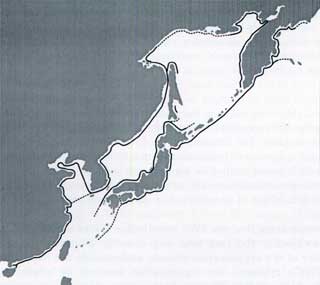
Migration routes of western Pacific gray whales
line - Repoted routes
dotted line - Probable routes
THERE EXISTED A MIGRATION ROUTE OF THE GRAY WHALE IN THE WEST COAST OF THE JAPANESE ARCHIPELAGO
The IWC and its members seem to have done the impossible once again. Namely, to speak out of both sides of their collective mouths at the same time.
The IWC refuses to apply one rule collectively. It seems vastly unfair and undemocratic to allow the native peoples of one culture to continue in the taking of cetacean species for food sources while refusing to allow other cultures to do the same. To argue that it is agreeable to allow Native Americans and Inuits to hunt because it is part of their heritage and culture, while ignoring the histories of Icelandic, Norwegian, and Japanese communities borders on political favoritism. In this day of dwindling food supplies, rising food costs, and rampant hunger in many parts of the world, it seems negligent to ignore the bounty that the sea might bestow upon us.
As distasteful as it might be to those with other means, the quantity of available food that the harvest of one minke whale allows could mean the difference between sustenance and starvation to a variety of native peoples. The industry of whaling alone assures the continued financial support of thousands that might have few other resources. The self-imposed limits that many countries have set upon the taking of endangered cetacean species allows that they are concerned and sensitive to effect of unrestricted or unregulated commercial whaling.
It would seem that the IWC could make better use of it's time by acknowledging the fact that any country interested in being a member of it's organization already understands the importance of the IWCfs mission. No organization succeeds by alienating it's members or possible allies.
We do not condemn the Hindu practice of refraining to slaughter cattle even though vast numbers of people could avoid starvation in countries that foster such beliefs. How then, does it make any sense to condemn countries that seek to sustain their people by continuing traditions that go back for dozens of generations? Surely, the ability to feed and sustain onefs family and community ranks the highest on anyonefs list of priorities.
While I would be among the first to look for other means of food production and financial independence, I could not in good conscience allow humans to suffer for want of practical application of natural resources. I honestly believe that some kind of median is possible while protecting the rights of all concerned.
As a scientist, I have watched while millions of dollars have been spent on the unsuccessful attempt to rehabilitate one captive killer whale. How many human lives could have been affected by the same influx of cash? How many industries could have been bolstered by such an investment? How many alternative food sources could have been found with that amount of revenue?
I have spent the majority of my life trying to better understand the vast oceans of our planet and their inhabitants. My study of whales and dolphins have presented many fascinating hours as I attempt to understand the life they lead, but I would not for one moment place the value of their lives over that of a human being. I understand the hierarchy of living beings and respect it. While it is my choice not to consume the flesh of a fellow predator, I have the luxury of making that choice. I do not believe that other carnivores on the planet would have the same regard for me, nor would I expect them to do so.
While I may make a choice not to consume whale meat, I was raised in a culture where that is not the usual source of protein. If I had been born in another land, I'm sure I would feel differently. Before I could, in good conscience, ask another society to alter their way of life, I would have to be able to offer an alternative method for their continued survival; a method that would not only allow them to prosper, but that did not offend their sense of culture and history.
It seems as though the International Whaling Committee would have much more success if it remembered that the most basic requirement for cooperation is mutual respect.
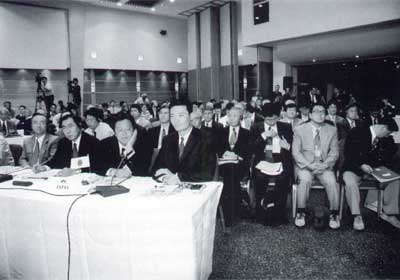
Migration routes of western Pacific gray whales
line - Repoted routes
dotted line - Probable routes

